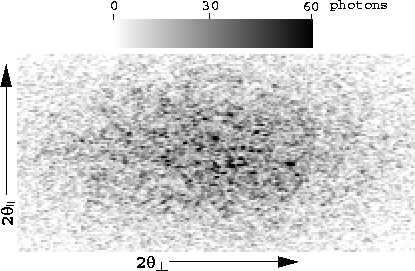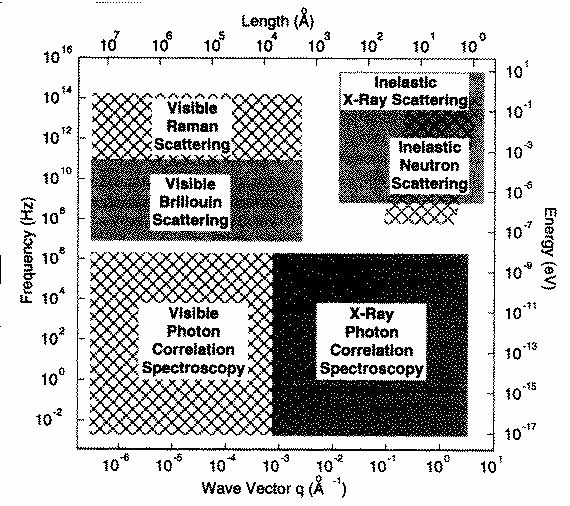What is X-ray Photon Correlation Spectroscopy (XPCS)?
What is X-ray Photon Correlation Spectroscopy (XPCS)?
(this page was last updated in 1995)
XPCS is a novel technique that studies the slow dynamics of various equilibrium and non-equilibrium processes occuring in condensed matter systems.
It is based on the generation of a speckle pattern by the scattered
coherent light originating from a material where
some spatial inhomogeneities are present.
A speckle pattern is a diffraction limited
structure factor, and is typically observed when laser light is reflected
from a rough surface, or from dust particles performing Brownian motion in
air. The observation of speckle patterns with hard X-rays has just
been demonstrated in the last few years. This observation is only possible
now because of the development of new
synchrotron radiation X-ray
sources that can provide sufficient coherent flux.
Figure 1 shows a speckle pattern from from
frozen domain walls in Cu3Au.
The image was generated with 7 keV X-rays, and measured one meter away from the sample with a X-ray sensitive CCD.
Notice the large random spatial variation of the intensity.
With an incoherent illumination, these spatial variation are not observed.
If the state of disorder of the system changes with time, the speckle pattern
will change, thus by studying the time dependence of the scattered
intensity at a fixed wavevector, one can probe the dynamics
of materials in thermodynamic equilibrium or out of equilibrium.
Figure 2 shows the potential of XPCS for exploring the
dynamics of various processes in condensed matter
system in an uncharted area of time scale and
reciprocal space. The potential for discovering new types of
dynamical phenomenon at atomic length scales makes it a very exciting
new field of research.

Fig. 1: A speckle pattern of Cu3Au (100) measured at room temperature
after the sample had been ordered for 16 hours.
This ordering was necessary to observe
sufficient intensity from the weak scattering of the initially
small Cu3Au domains. The grey scale displayed shows detected
counts per pixel, for a 2 minutes exposure at a standard current of 200 mA.
The beam was collimated with a 7.5 micron pinhole to preserve the
transverse coherence of the X-ray beam.

Figure 2: The region of wavevector-energy space covered by various techniques
is indicated. XPCS would provide a unique probe in a previously
inaccessible region. Thise figure is borrowed from Steve Dierker's review
of XPCS in the July 1995 version of the NSLS Newsletter (see p6).
Useful XPCS links
 Back to my homepage (retour vers ma page maison).
Back to my homepage (retour vers ma page maison).
Récemment modifié le 25/03/27, par Eric Dufresne.


 Back to my homepage (retour vers ma page maison).
Back to my homepage (retour vers ma page maison).